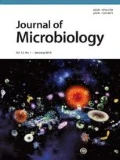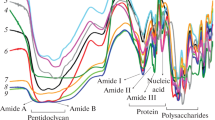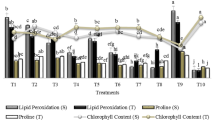Abstract
Paenibacillus polymyxa is a promising plant-growth-promoting rhizobacterium that associates with a wide range of host plants, including agronomically important ones. Inoculation of wheat seedlings with P. polymyxa strains CCM 1465 and 92 was found to increase the mitotic index of the root cells 1.2- and 1.6-fold, respectively. Treatment of seedlings with the exopolysaccharides (EPSs) of these strains increased the mitotic index 1.9-fold (P. polymyxa CCM 1465) and 2.8-fold (P. polymyxa 92). These increases indicate activation of cell division in the root meristems. Analysis of the morphometric variables of the seedlings showed that P. polymyxa CCM 1465, P. polymyxa 92, and their EPSs promoted wheat growth, increasing root and shoot length up to 22% and root and shoot dry weight up to 28%, as compared with the control. In addition, both strains were found to intensely colonize the seedling root surface. Thus, P. polymyxa EPSs are active metabolites that, along with whole cells, are responsible for the contact interactions of the bacteria with wheat roots and are implicated in the induction of plant responses to these interactions. The strains used in this work are of interest for further study to broaden the existing understanding of the mechanisms of plant–bacterial interactions and to develop effective biofertilizers for agricultural purposes.
Similar content being viewed by others
References
Anand, R., Grayston, S., and Chanway, C. 2013. N2-fixation and seedling growth promotion of lodgepole pine by endophytic Paenibacillus polymyxa. Microb. Ecol. 66, 369–374.
Aswathy, A.J., Jasim, B., Jyothis, M., and Radhakrishnan, E.K. 2013. Identification of two strains of Paenibacillus sp. as indole 3 acetic acid-producing rhizome-associated endophytic bacteria from Curcuma longa. 3 Biotech 3, 219–224.
Baldani, V.L.D., Baldani, J.I., and Döbereiner, J. 1983. Effects of Azospirillum inoculation on root infection and nitrogen incorporation in wheat. Can. J. Microbiol. 29, 924–929.
Elkonin, L.A., Gudova, T.N., Ishin, A.G., and Tyrnov, U.S. 1993. Diploidization in haploid tissue cultures of sorghum. Plant Breed. 110, 201–206.
Evseeva, N.V., Matora, L.Y., Burygin, G.L., Dmitrienko, V.V., and Shchyogolev, S.Y. 2011. Effect of Azospirillum brasilense Sp245 lipopolysaccharide on the functional activity of wheat root meristematic cells. Plant Soil 346, 181–188.
Evseeva, N.V., Tkachenko, O.V., Burygin, G.L., Matora, L.Y., Lobachev, Y.V., and Shchyogolev, S.Y. 2018. Effect of bacterial lipopolysaccharides on morphogenetic activity in wheat somatic calluses. World J. Microbiol. Biotechnol. 34, 3.
Fedonenko, Y.P., Egorenkova, I.V., Konnova, S.A., and Ignatov, V.V. 2001. Involvement of the lipopolysaccharides of azospirilla in the interaction with wheat seedling roots. Microbiology 70, 329–334.
Gaskins, M.H. and Hubbell, D.H. 1979. Response of non-leguminous plants to root inoculation with free-living diazotrophic bacteria. In Harley, J.L. and Russell, R.S. (eds.), The soil-root interface, pp. 175–182. Academic Press, New York, USA.
Grady, E.N., MacDonald, J., Liu, L., Richman, A., and Yuan, Z.C. 2016. Current knowledge and perspectives of Paenibacillus: a review. Microb. Cell Fact. 15, 203.
Grinev, V.S., Tregubova, K.V., Anis'kov, A.A., Sigida, E.N., Shirokov, A.A., Fedonenko, Y.P., and Yegorenkova, I.V. 2020. Isolation, structure and potential biotechnological applications of the exopolysaccharide from Paenibacillus polymyxa 92. Carbohydr. Polym. 232, 115780.
Haggag, W.M. 2007. Colonization of exopolysaccharide-producing Paenibacillus polymyxa on peanut roots for enhancing resistance against crown rot disease. Afr. J. Biotechnol. 6, 1568–1577.
Hao, T. and Chen, S. 2017. Colonization of wheat, maize and cucumber by Paenibacillus polymyxa WLY78. PLoS ONE 12, e0169980.
Ivanov, V.B. 2004. Meristem as a self-renewing system: maintenance and cessation of cell proliferation (a review). Russ. J. Plant Physiol. 51, 834–847.
Jain, D.K. and Patriquin, D.G. 1984. Root hair deformation, bacterial attachment and plant growth in wheat-Azospirillum associations. Appl. Environ. Microbiol. 48, 1208–1213.
Khan, M.S., Gao, J., Chen, X., Zhang, M., Yang, F., Du, Y., Moe, T.S., Munir, I., Xue, J., and Zhang, X. 2020. Isolation and characterization of plant growth-promoting endophytic bacteria Paenibacillus polymyxa SK1 from Lilium lancifolium. Biomed Res. Int. 2020, 8650957.
Lal, S. and Tabacchioni, S. 2009. Ecology and biotechnological potential of Paenibacillus polymyxa: a minireview. Indian J. Microbiol. 49, 2–10.
Lee, S.A., Kim, T.W., Heo, J., Sang, M.K., Song, J., Kwon, S.W., and Weon, H.Y. 2020. Paenibacillus lycopersici sp. nov. and Paenibacillus rhizovicinus sp. nov. isolated from the rhizosphere of tomato (Solanum lycopersicum). J. Microbiol. 58, 832–840.
Levanony, H. and Bashan, Y. 1989. Enhancement of cell division in wheat root tips and growth of root elongation zone induced by Azospirillum brasilense Cd. Can. J. Bot. 67, 2213–2216.
Liang, T.W. and Wang, S.L. 2015. Recent advances in exopolysaccharides from Paenibacillus spp.: production, isolation, structure, and bioactivities. Mar. Drugs 13, 1847–1863.
Liu, J., Luo, J., Ye, H., and Zeng, X. 2012. Preparation, antioxidant and antitumor activities in vitro of different derivatives of levan from endophytic bacterium Paenibacillus polymyxa EJS-3. Food Chem. Toxicol. 50, 767–772.
Maes, M. and Baeyen, S. 2003. Experiences and perspectives for the use of a Paenibacillus strain as a plant protectant. Commun. Agric. Appl. Biol. Sci. 68, 457–462.
McSpadden Gardener, B.B. 2004. Ecology of Bacillus and Paenibacillus species in agricultural systems. Phytopathology 94, 1252–1258.
Puri, A., Padda, K., and Chanway, C. 2016. Seedling growth promotion and nitrogen fixation by a bacterial endophyte Paenibacillus polymyxa P2b-2R and its GFP derivative in corn in a long-term trial. Symbiosis 69, 123–129.
Rafigh, S.M., Yazdi, A.V., Vossoughi, M., Safekordi, A.A., and Ardjmand, M. 2014. Optimization of culture medium and modeling of curdlan production from Paenibacillus polymyxa by RSM and ANN. Int. J. Biol. Macromol. 70, 463–473.
Raza, W., Makeen, K., Wang, Y., Xu, Y., and Qirong, S. 2011. Optimization, purification, characterization and antioxidant activity of an extracellular polysaccharide produced by Paenibacillus polymyxa SQR-21. Bioresour. Technol. 102, 6095–6103.
Raza, W., Yuan, J., Ling, N., Huang, Q., and Shen, Q. 2015. Production of volatile organic compounds by an antagonistic strain Paenibacillus polymyxa WR-2 in the presence of root exudates and organic fertilizer and their anti-fungal activity against Fusarium oxysporum f. sp. niveum. Biol. Control 80, 89–95.
Redmile-Gordon, M.A., Brooks, P.C., Evershed, R.P., Goulding, K.W.T., and Hirsch, P.R. 2014. Measuring the soil-microbial interface: Extraction of extracellular polymeric substances (EPS) from soil biofilms. Soil Biol. Biochem. 72, 163–171.
Rybakova, D., Cernava, T., Köberl, M., Liebminger, S., Etemadi, M., and Berg, G. 2016. Endophytes-assisted biocontrol: novel insights in ecology and the mode of action of Paenibacillus. Plant Soil 405, 125–140.
Shishido, M., Breuil, C., and Chanway, C.P. 1999. Endophytic colonization of spruce by plant growth-promoting rhizobacteria. FEMS Microbiol. Ecol. 29, 191–196.
Sumaroka, M.V., Dykman, L.A., Bogatyrev, V.A., Evseeva, N.V., Zaitseva, I.S., Shchyogolev, S.Y., and Volodarsky, A.D. 2000. Use of the dot-blot immunogold assay to identify a proliferative antigen of the initial cells of a wheat stem meristem. J. Immunoassay 21, 401–410.
Timmusk, S., Copolovici, D., Copolovici, L., Teder, T., Nevo, E., and Behers, L. 2019. Paenibacillus polymyxa biofilm polysaccharides antagonise Fusarium graminearum. Sci. Rep. 9, 662.
Timmusk, S., Grantcharova, N., and Wagner, E.G.H. 2005. Paenibacillus polymyxa invades plant roots and forms biofilms. Appl. Environ. Microbiol. 71, 7292–7300.
Ulrich, K., Stauber, T., and Ewald, D. 2008. Paenibacillus—a predominant endophytic bacterium colonising tissue cultures of woody plants. Plant Cell Tiss. Organ Cult. 93, 347–351.
Vasilyev, N.V., Lutsik, N.B., Paliy, G.K., and Smirnova, O.V. 1984. Biokhimiya i immunologiya mikrobnykh polisakharidov (Biochemistry and immunology of microbial polysaccharides). Tomsk University Publishing House, Tomsk, Russian. http://vital.lib.tsu.ru/vital/access/manager/Repository/vtls:000632379.
Wang, Y., Shi, Y., Li, B., Shan, C., Ibrahim, M., Jabeen, A., Xie, G., and Sun, G. 2012. Phosphate solubilization of Paenibacillus polymyxa and Paenibacillus macerans from mycorrhizal and nonmycorrhizal cucumber plants. Afr. J. Microbiol. Res. 6, 4567–4573.
Yegorenkova, I.V., Fomina, A.A., Tregubova, K.V., Konnova S.A., and Ignatov, V.V. 2018. Immunomodulatory activity of exopolysaccharide from the rhizobacterium Paenibacillus polymyxa CCM 1465. Arch. Microbiol. 200, 1471–1480.
Yegorenkova, I.V., Konnova, S.A., Sachuk, V.N., and Ignatov, V.V. 2001. Azospirillum brasilense colonisation of wheat roots and the role of lectin-carbohydrate interactions in bacterial adsorption and root-hair deformation. Plant Soil 231, 275–282.
Yegorenkova, I.V., Tregubova, K.V., and Ignatov, V.V. 2013. Paenibacillus polymyxa rhizobacteria and their synthesized exoglycans in interaction with wheat roots: colonization and root hair deformation. Curr. Microbiol. 66, 481–486.
Yegorenkova, I.V., Tregubova, K.V., Konnova, S.A., Bugreyeva, L.V., and Ignatov, V.V. 2016. Effect of exopolysaccharides of the bacterium Paenibacillus polymyxa 1465 on growth and defense responses of wheat. Izv. Saratov. Univ. Ser. Chem. Biol. Ecol. 16, 414–420.
Yegorenkova, I.V., Tregubova, K.V., Matora, L.Y., Burygin, G.L., and Ignatov, V.V. 2008. Composition and immunochemical characteristics of exopolysaccharides from the rhizobacterium Paenibacillus polymyxa 1465. Microbiology 77, 553–558.
Yegorenkova, I.V., Tregubova, K.V., Matora, L.Y., Burygin, G.L., and Ignatov, V.V. 2010. Use of ELISA with antiexopolysaccharide antibodies to evaluate wheat-root colonization by the rhizobacterium Paenibacillus polymyxa. Curr. Microbiol. 61, 376–380.
Yegorenkova, I.V., Tregubova, K.V., Matora, L.Y., Burygin, G.L., and Ignatov, V.V. 2011. Biofilm formation by Paenibacillus polymyxa strains differing in the production and rheological properties of their exopolysaccharides. Curr. Microbiol. 62, 1554–1559.
Yi, J., Zhang, D., Cheng, Y., Tan, J., and Luo, Y. 2019. The impact of Paenibacillus polymyxa HY96-2 luxS on biofilm formation and control of tomato bacterial wilt. Appl. Microbiol. Biotechnol. 103, 9643–9657.
York, G.M., González, J.E., and Walker, G.C. 1996. Exopolysaccharides and their role in nodule invasion. In Stacey, G., Mullin, B., and Gresshoff, P.M. (eds.), Biology of plant-microbe interactions: Proceedings of the 8th International Symposium on Molecular Plant-Microbe Interactions, Knoxville, Tennessee, July 14-19, 1996, pp. 325–330. Society for Molecular Plant-Microbe Interactions, St. Paul, Minnesota, USA.
Yu, Z., Zhu, Y., Qin, W., Yin, J., and Qiu, J. 2017. Oxidative stress induced by polymyxin E is involved in rapid killing of Paenibacillus polymyxa. Biomed. Res. Int. 2017, 5437139.
Yuan, Y., Xu, Q.M., Yu, S.C., Sun, H.Z., Cheng, J.S., and Yuan, Y.J. 2020. Control of the polymyxin analog ratio by domain swapping in the nonribosomal peptide synthetase of Paenibacillus polymyxa. J. Ind. Microbiol. Biotechnol. 47, 551–562.
Zhang, F., Li, X.L., Zhu, S.J., Ojaghian, M.R., and Zhang, J.Z. 2018. Biocontrol potential of Paenibacillus polymyxa against Verticillium dahliae infecting cotton plants. Biol. Control 127, 70–77.
Acknowledgements
This research did not receive any specific grant from funding agencies in the public, commercial, or not-for-profit sectors.
Our thanks go to Dmitry N. Tychinin for the translation of the original manuscript into English and to Gennady L. Burygin for his technical assistance in the preparation of the manuscript.
Author information
Authors and Affiliations
Corresponding author
Additional information
Conflict of Interest
The authors have no conflicts of interest to report.
Rights and permissions
About this article
Cite this article
Yegorenkova, I.V., Tregubova, K.V., Krasov, A.I. et al. Effect of exopolysaccharides of Paenibacillus polymyxa rhizobacteria on physiological and morphological variables of wheat seedlings. J Microbiol. 59, 729–735 (2021). https://doi.org/10.1007/s12275-021-0623-9
Received:
Revised:
Accepted:
Published:
Issue Date:
DOI: https://doi.org/10.1007/s12275-021-0623-9




